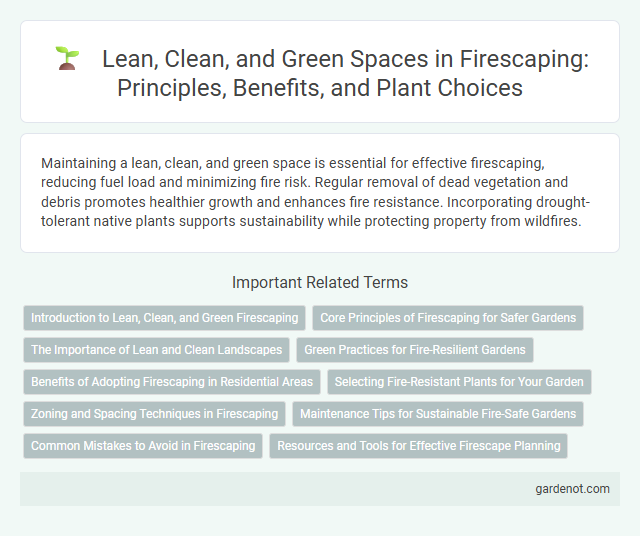Maintaining a lean, clean, and green space is essential for effective firescaping, reducing fuel load and minimizing fire risk. Regular removal of dead vegetation and debris promotes healthier growth and enhances fire resistance. Incorporating drought-tolerant native plants supports sustainability while protecting property from wildfires.
Introduction to Lean, Clean, and Green Firescaping
Lean, clean, and green firescaping emphasizes the strategic removal of flammable vegetation, debris, and dry materials to create defensible spaces around properties, reducing wildfire risk. Incorporating native, drought-resistant plants that require minimal maintenance supports ecosystem health while enhancing fire resistance. This approach balances fire prevention with environmental sustainability, promoting safer, more resilient landscapes.
Core Principles of Firescaping for Safer Gardens
Firescaping emphasizes lean, clean, and green spaces by minimizing flammable materials and maintaining well-spaced, fire-resistant plants to reduce wildfire risks. Core principles include removing dead vegetation, creating defensible zones, and selecting native, drought-tolerant species that act as natural fire barriers. Proper maintenance, such as regular pruning and debris clearance, supports safer gardens by preventing fuel build-up and promoting fire resilience.
The Importance of Lean and Clean Landscapes
Maintaining lean and clean landscapes significantly reduces wildfire risks by eliminating excess vegetation and removing dead plant material that can fuel fires. Strategic pruning, proper spacing, and regular debris removal create defensible spaces that enhance fire resistance and protect properties. These practices not only improve safety but also promote a healthy, sustainable environment by supporting native plants and conserving water.
Green Practices for Fire-Resilient Gardens
Incorporating drought-tolerant native plants reduces water usage while enhancing fire resistance in garden landscapes. Mulching with organic materials like wood chips suppresses weed growth and retains soil moisture, promoting healthier plants less susceptible to fire damage. Sustainable irrigation techniques, such as drip systems, optimize water efficiency and maintain robust vegetation that acts as natural firebreaks.
Benefits of Adopting Firescaping in Residential Areas
Adopting firescaping in residential areas reduces wildfire risks by incorporating lean, clean, and green space management techniques that minimize combustible vegetation and create defensible zones around homes. This approach enhances property protection, increases environmental sustainability through native plant use, and improves air quality by reducing smoke and pollutant emissions during fire events. Homeowners benefit from lower insurance premiums and peace of mind knowing their landscapes are designed to resist fire spread effectively.
Selecting Fire-Resistant Plants for Your Garden
Selecting fire-resistant plants with high moisture content and low resin levels helps create a lean, clean, and green firescape that reduces wildfire risk. Incorporate species such as succulents, deciduous trees, and native shrubs known for their fire-resistant qualities to maintain an attractive yet defensible garden. Regular maintenance including pruning dead material and removing flammable debris ensures optimal fire resistance in your landscaped area.
Zoning and Spacing Techniques in Firescaping
Effective firescaping relies heavily on strategic zoning and spacing techniques to create lean, clean, and green spaces that minimize wildfire risks. By establishing defensible zones with proper spacing between vegetation, homeowners can reduce fuel loads and slow fire spread, ensuring both safety and landscape health. Incorporating fire-resistant plants and maintaining clear separations between tree canopies, shrubs, and structures optimizes these zones for enhanced wildfire resilience.
Maintenance Tips for Sustainable Fire-Safe Gardens
Maintaining lean, clean, and green firescaping involves regular pruning of dead or overgrown vegetation to reduce fuel load and prevent fire spread. Consistent removal of fallen leaves, branches, and debris around your garden minimizes ignition risks and supports sustainability. Utilizing native, drought-tolerant plants further enhances fire resistance while conserving water and promoting ecological balance.
Common Mistakes to Avoid in Firescaping
Avoid overcrowding plants with excessive mulch, as this can trap moisture and increase fire risk in firescaping. Selecting non-fire-resistant vegetation and placing flammable materials near structures undermine the effectiveness of lean, clean, and green space principles. Maintaining consistent debris removal and ensuring proper spacing between vegetation are critical to minimizing fire hazards in defensible landscapes.
Resources and Tools for Effective Firescape Planning
Effective firescape planning relies on lean, clean, and green space principles to maximize wildfire resilience while conserving resources. Utilizing tools such as GIS mapping, defensible space calculators, and fire behavior models enables precise vegetation management and fuel reduction strategies. Integrating native plants and drought-tolerant landscaping enhances ecological sustainability and reduces water consumption during fire prevention efforts.
Lean, clean, and green space Infographic

 gardenot.com
gardenot.com